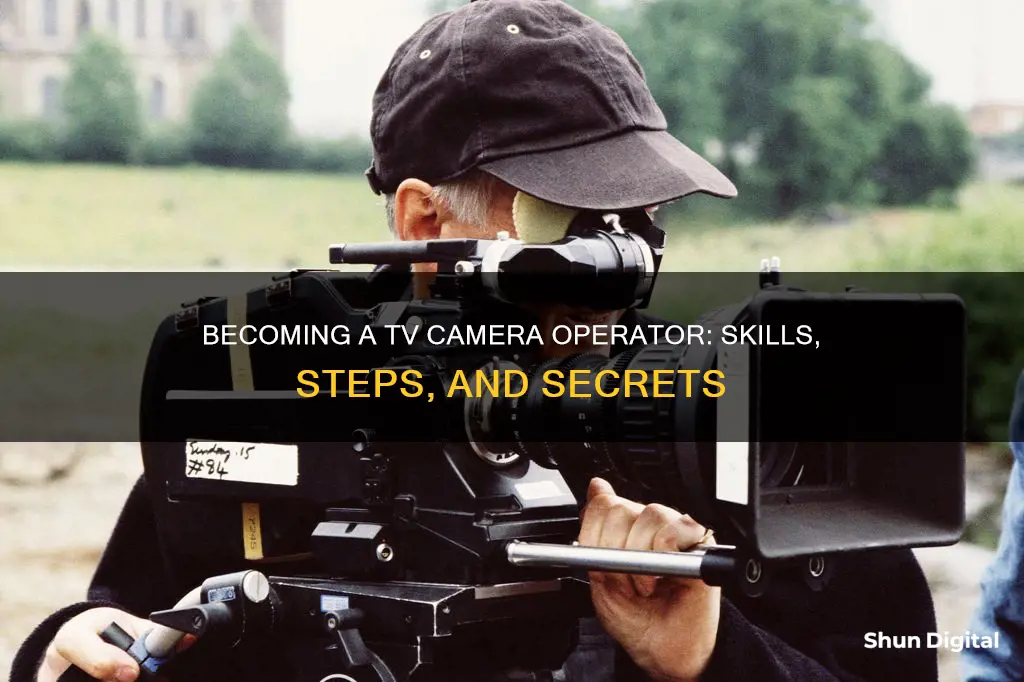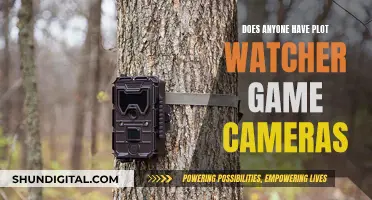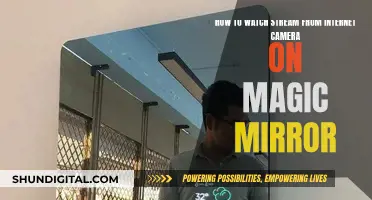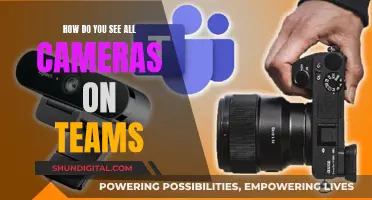
A TV camera operator is responsible for capturing the action and shooting what's happening, whether that's on location for a news programme or documentary, or on a large multi-camera studio show. They are the person on set who operates the camera, working under the guidance of the director and cinematographer to physically capture their vision.
To become a TV camera operator, you'll need to have a good understanding of camera equipment and be able to work well under pressure. While there are no specific entry requirements, a degree in a relevant subject such as media production, media technology or photography can be useful. Building a portfolio of previous work and networking with industry contacts is also important to help you secure a job.
| Characteristics | Values |
|---|---|
| Education | No specific entry requirements, but a relevant tertiary qualification in film, television, or video production is useful. |
| Experience | Working for a production company or having video or television work experience is useful. |
| Skills | Technical skills for operating film and video cameras, up-to-date knowledge of filming methods and equipment, knowledge of camera exposure, focus, colour, and lighting, and an understanding of the filming and editing process. |
| Personal qualities | Able to work well under pressure, good problem-solving skills, efficient and reliable, good communicators with strong people skills. |
| Physical requirements | Good level of fitness as they stand for extended periods and carry heavy camera equipment. They also need to have good hearing and normal colour vision. |
What You'll Learn

Camera operation and maintenance
Camera operators are responsible for capturing the action and shooting what's happening, whether that's on location for a news programme, documentary, or on a large multi-camera studio show or a major outside broadcast. They are in charge of the camera equipment's movement and maintenance.
A camera operator's day might begin by getting a shot list or schedule from the first assistant director, and then discussing what equipment is necessary to capture the day's shots. They will then set up and assemble the equipment. They are often the only ones on set who see how everything is being shot in the moment, so they must correct and adjust anything that doesn't match the director or DP's vision.
Camera operators must know which cameras to use in which conditions and consider the composition, framing, and movement of a shot. They also select the most suitable lenses and camera angles, and plan and rehearse shots.
Camera operators are responsible for taking care of the kit and often own their equipment. They are often skilled at lighting and are sometimes known as lighting camera operators. They may also be in charge of the sound.
Camera operators must have an in-depth understanding of the latest motion picture equipment, cameras, lenses, monitors, and lights. They must also be able to use the equipment that operates cameras, such as dollies, rigs, and cranes. They need to understand the essentials of the "exposure triangle", which includes adjusting settings such as a camera's ISO, aperture, and shutter speed to get the proper exposure.
Camera operators need to be able to work well under pressure, have good problem-solving skills, be efficient and reliable, and have good communication skills.
Paranormal Caught on Camera: Season 7 Viewing Options
You may want to see also

Camera angles and lenses
Camera Angles
- Establishing shot: Usually a wide-angle shot used to introduce a setting, often an exterior shot of a building where the action takes place. It shows off locations and crowd scenes or distances the camera from the subject.
- Long shot: Shows the entire person's body from head to foot, with the subject filling the frame. This is used to showcase important actions, such as running or dancing, or when introducing characters.
- Medium shot: Shows the person from the waist up. This is good for general conversations or basic action, as it is not too close but brings the audience in to see details like facial expressions.
- Close-up: Usually a shot of the head and shoulders, though it can vary. Close-ups are intimate and good for showcasing facial expressions. Conversations between two people are often cut between close-ups.
- Extreme close-up: The subject's face or other attributes (eyes, hands, mouth, etc.) fill the entire frame. These are used rarely and only when a specific detail needs to be shown, such as eyes squinting or an object being picked up.
- Two-shot: This is a shot of two people in the frame, who can be talking, walking side by side, or interacting in any other manner. A two-shot can be done using long shots, medium shots, or close-ups.
- Over-the-shoulder: When two people are facing each other while talking, the camera is placed over one of the character's shoulders to focus on the person speaking. You should see the back of the head and part of the shoulder of the person in the foreground.
Lenses
The practical angle of view of a lens depends on the camera's sensor size. A larger angle of view corresponds to a wider lens, allowing you to fit more perspective within the frame. Conversely, a smaller angle of view gives you a narrower perspective, as you might get with a telephoto lens.
When choosing a lens, it is important to consider the angle of view and how much perspective you want to capture in the frame. For example, when shooting architecture or landscapes, you typically want to fit a wide perspective in the frame.
Different types of camera lenses include:
- Fisheye lenses: These lenses have a focal length between 8mm and 10mm for circular images and 15-16mm for full-frame images. They can capture up to 180-degree angles of view or more.
- Ultra wide-angle lenses: Rectilinear lenses with a focal length of less than 24mm in 35mm film format. They offer an angle of view between 114 and 84 degrees.
- Wide-angle lenses: Lenses with a focal length between 24mm and 35mm in 35mm film format, offering an angle of view between 84 and 64 degrees.
- Normal or standard lenses: Lenses with a focal length between 36mm and 60mm in 35mm film format, providing an angle of view between 62 and 40 degrees.
- Long focus lenses: Any lens with a focal length greater than the diagonal of the film or sensor used. They typically have an angle of view of 35 degrees or less.
Camera Movement
In addition to angles and lenses, camera movement can also enhance the visual storytelling. This includes techniques such as:
- Dolly shots: Physically moving the camera toward or away from the subject to change the perspective and create a sense of movement.
- Tracking shots: Moving the camera from side to side or through all three dimensions to follow an action, such as a character walking.
- Point of view (POV): Using the camera as the character's eyes, showing the audience exactly what the character is seeing.
- High-angle shots: Shooting from a higher angle than the subject, which can diminish the subject and make them appear smaller.
- Low-angle shots: Shooting from a lower angle than the subject, which can heighten the dramatic element and make the subject appear larger than life.
Zmodo Cameras on Fire Stick: Easy Viewing
You may want to see also

Filming and editing process
Camera operators are responsible for capturing the action and making the director's vision a reality. They work with the director of photography and the director to select the right camera, lenses, and equipment for each shot, and ensure the correct lighting and framing. Camera operators need to be able to adapt to different shooting styles and genres, and they often work in a range of conditions, from studios to outdoor locations.
On a typical day, a camera operator will receive a shot list or schedule from the first assistant director or communicate directly with the director about how the shot should be executed. They will then discuss and set up the necessary equipment, which may include cameras, lighting rigs, dollies, cranes, and other accessories. Camera operators also supervise the selection and preparation of lenses, rigs, and other accessories, ensuring the correct camera movement and maintenance. They may need to rehearse shots, especially if they are more complex and involve a Steadicam rig.
During filming, camera operators follow the director's instructions and work with the camera crew to capture the desired shots. They may need to adjust framing, camera angles, and lighting on the spot. Camera operators are often the only ones on set who see how everything is being shot in real time, so they have the important responsibility of ensuring that the director's vision is accurately captured.
After a day of shooting, camera operators help the camera team break down and organise the equipment. They may also be involved in the editing process, working with the director and editor to provide input on the footage and ensure it aligns with the desired outcome.
Camera operators need to have a thorough understanding of the filming and editing process, including technical knowledge of camera equipment, lighting, and sound. They should also be able to work well under pressure, as the filming process can be fast-paced and demanding.
Exploring Live Street Cameras: A Beginner's Guide
You may want to see also

Camera equipment setup
Camera Choice and Placement:
Camera operators need to select the appropriate camera for the shoot. This choice is influenced by factors such as the shooting location, the desired visual style, and the specific requirements of the director or cinematographer. Camera operators should be familiar with a range of camera types, including handheld cameras, cameras mounted on body frames (Steadicam), and drones. They also need to consider the camera angle and position to ensure they capture the desired shot.
Lighting and Exposure:
Lighting plays a significant role in the overall look and feel of the footage. Camera operators should have a good understanding of lighting techniques and work closely with lighting technicians or gaffers. They adjust lighting equipment, such as rigs and kits, to achieve the desired exposure and visual effect. This involves manipulating factors like camera exposure, ISO, aperture, and shutter speed.
Lenses and Accessories:
Camera operators are responsible for choosing the right lenses for each shot. Different lenses offer varied focal lengths, apertures, and optical characteristics, all of which impact the final image. Operators also need to oversee the selection and preparation of various shooting accessories, including rigs, cranes, dollies, and filters. These accessories enable specific types of shots and camera movements.
Maintenance and Troubleshooting:
Camera operators are in charge of maintaining and troubleshooting camera equipment. This involves regular cleaning and calibration of the equipment, as well as responding to any technical issues that may arise during a shoot. Operators should be able to identify and resolve common camera issues promptly to minimise disruptions.
Collaboration and Communication:
Setting up camera equipment is rarely a solo endeavour. Camera operators collaborate closely with other members of the camera crew, including camera assistants, grips, and gaffers. Effective communication and coordination are essential to ensure the smooth and efficient setup of the equipment. Operators also take instructions from the director, cinematographer, or floor manager to ensure the setup aligns with the creative vision of the production.
Practice and Preparation:
Camera operators should be well-prepared and familiar with the equipment they will be using. This includes practising with the equipment beforehand, especially for complex shots or camera movements. They may also need to participate in rehearsals, ensuring that the camera setup is refined and ready for the actual shoot.
By following these guidelines and developing their technical skills, TV camera operators can ensure they have the right equipment setup to capture the desired footage and bring the director's vision to life.
Frontier Watch: Camera-Equipped or Not?
You may want to see also

Industry networking
Networking is crucial to landing a job as a TV camera operator. It is a very small and competitive industry, and many jobs are obtained through knowing people in the industry.
To get started, you can try to find work experience by writing to local production companies and asking if they offer any. Keep an eye out for work experience opportunities at major networks like the BBC, ITV, and Channel 4. You can also look for trainee programmes, such as ScreenSkills' Trainee Finder, which offers paid placements in film and TV production.
You can also try to make connections by attending industry events and meeting professionals. Offer to provide them with your professional contact details and try to stay in touch. You can also create a LinkedIn profile and join Facebook groups or other social media groups for people in the industry in your area. There might even be groups for runners and trainees that you can join.
Another way to build your network is to get an apprenticeship or entry-level job with a production company or camera equipment hire company. This will allow you to build up contacts in the industry while also gaining practical experience.
Finally, if you are able to attend film school, this can also provide a network of contacts that can be vital when searching for entry-level jobs.
Caught on Camera: Where to Watch This Show
You may want to see also
Frequently asked questions
While there are no specific entry requirements, a relevant tertiary qualification in film, television or video production is useful. Relevant courses include degrees in media production, media technology or photography.
TV camera operators need to have technical skills for operating film and video cameras, up-to-date knowledge of filming methods and equipment, and knowledge of camera exposure, focus, colour and lighting. They also need to be able to work well under pressure, have good problem-solving skills, and be efficient and reliable.
According to Salary.com, as of November 2022, the salary range for a camera operator is between $71,964 and $108,186. On average, a camera operator's salary is around $86,598 a year.







